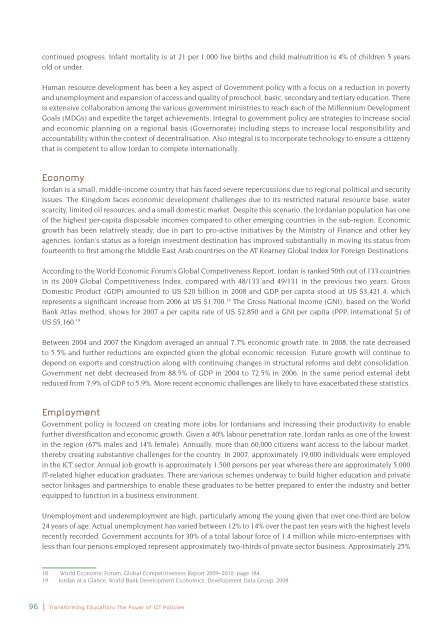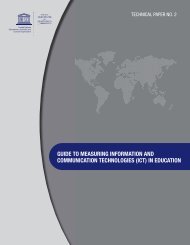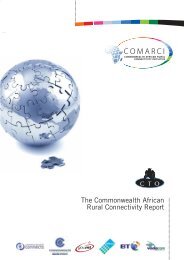Transforming education: the power of ICT policies - Commonwealth ...
Transforming education: the power of ICT policies - Commonwealth ...
Transforming education: the power of ICT policies - Commonwealth ...
Create successful ePaper yourself
Turn your PDF publications into a flip-book with our unique Google optimized e-Paper software.
continued progress. Infant mortality is at 21 per 1,000 live births and child malnutrition is 4% <strong>of</strong> children 5 years<br />
old or under.<br />
Human resource development has been a key aspect <strong>of</strong> Government policy with a focus on a reduction in poverty<br />
and unemployment and expansion <strong>of</strong> access and quality <strong>of</strong> preschool, basic, secondary and tertiary <strong>education</strong>. There<br />
is extensive collaboration among <strong>the</strong> various government ministries to reach each <strong>of</strong> <strong>the</strong> Millennium Development<br />
Goals (MDGs) and expedite <strong>the</strong> target achievements. Integral to government policy are strategies to increase social<br />
and economic planning on a regional basis (Governorate) including steps to increase local responsibility and<br />
accountability within <strong>the</strong> context <strong>of</strong> decentralisation. Also integral is to incorporate technology to ensure a citizenry<br />
that is competent to allow Jordan to compete internationally.<br />
Economy<br />
Jordan is a small, middle-income country that has faced severe repercussions due to regional political and security<br />
issues. The Kingdom faces economic development challenges due to its restricted natural resource base, water<br />
scarcity, limited oil resources, and a small domestic market. Despite this scenario, <strong>the</strong> Jordanian population has one<br />
<strong>of</strong> <strong>the</strong> highest per-capita disposable incomes compared to o<strong>the</strong>r emerging countries in <strong>the</strong> sub-region. Economic<br />
growth has been relatively steady, due in part to pro-active initiatives by <strong>the</strong> Ministry <strong>of</strong> Finance and o<strong>the</strong>r key<br />
agencies. Jordan’s status as a foreign investment destination has improved substantially in moving its status from<br />
fourteenth to fi rst among <strong>the</strong> Middle East Arab countries on <strong>the</strong> AT Kearney Global Index for Foreign Destinations.<br />
According to <strong>the</strong> World Economic Forum’s Global Competiveness Report, Jordan is ranked 50th out <strong>of</strong> 133 countries<br />
in its 2009 Global Competitiveness Index, compared with 48/133 and 49/131 in <strong>the</strong> previous two years. Gross<br />
Domestic Product (GDP) amounted to US $20 billion in 2008 and GDP per capita stood at US $3,421.4, which<br />
represents a signifi cant increase from 2006 at US $1,700. 18 The Gross National Income (GNI), based on <strong>the</strong> World<br />
Bank Atlas method, shows for 2007 a per capita rate <strong>of</strong> US $2,850 and a GNI per capita (PPP, international $) <strong>of</strong><br />
US $5,160. 19<br />
Between 2004 and 2007 <strong>the</strong> Kingdom averaged an annual 7.7% economic growth rate. In 2008, <strong>the</strong> rate decreased<br />
to 5.5% and fur<strong>the</strong>r reductions are expected given <strong>the</strong> global economic recession. Future growth will continue to<br />
depend on exports and construction along with continuing changes in structural reforms and debt consolidation.<br />
Government net debt decreased from 88.5% <strong>of</strong> GDP in 2004 to 72.5% in 2006. In <strong>the</strong> same period external debt<br />
reduced from 7.9% <strong>of</strong> GDP to 5.9%. More recent economic challenges are likely to have exacerbated <strong>the</strong>se statistics.<br />
Employment<br />
Government policy is focused on creating more jobs for Jordanians and increasing <strong>the</strong>ir productivity to enable<br />
fur<strong>the</strong>r diversifi cation and economic growth. Given a 40% labour penetration rate, Jordan ranks as one <strong>of</strong> <strong>the</strong> lowest<br />
in <strong>the</strong> region (67% males and 14% female). Annually, more than 60,000 citizens want access to <strong>the</strong> labour market,<br />
<strong>the</strong>reby creating substantive challenges for <strong>the</strong> country. In 2007, approximately 19,000 individuals were employed<br />
in <strong>the</strong> <strong>ICT</strong> sector. Annual job growth is approximately 1,500 persons per year whereas <strong>the</strong>re are approximately 5,000<br />
IT-related higher <strong>education</strong> graduates. There are various schemes underway to build higher <strong>education</strong> and private<br />
sector linkages and partnerships to enable <strong>the</strong>se graduates to be better prepared to enter <strong>the</strong> industry and better<br />
equipped to function in a business environment.<br />
Unemployment and underemployment are high, particularly among <strong>the</strong> young given that over one-third are below<br />
24 years <strong>of</strong> age. Actual unemployment has varied between 12% to 14% over <strong>the</strong> past ten years with <strong>the</strong> highest levels<br />
recently recorded. Government accounts for 30% <strong>of</strong> a total labour force <strong>of</strong> 1.4 million while micro-enterprises with<br />
less than four persons employed represent approximately two-thirds <strong>of</strong> private sector business. Approximately 25%<br />
18 World Economic Forum, Global Competitiveness Report 2009–2010, page 184.<br />
19 Jordan at a Glance, World Bank Development Economics, Development Data Group, 2008.<br />
96 | <strong>Transforming</strong> Education: The Power <strong>of</strong> <strong>ICT</strong> Policies
















